The cold and rain didn’t dampen enthusiasm for the opening of Metro’s long-awaited, $3 billion Silver Line Phase II.
Yesterday marked the much-anticipated public opening of the 11.4-mile extension of the rail line from Reston into Loudoun County. Along with six new stations, this marks the first time that locals can take a train to Dulles International Airport.
Over multiple ribbon-cutting ceremonies throughout the chilly, wet November day, local officials touted the debut of the line as a “game-changer” and a “new era” for western Fairfax County and the D.C. region as a whole.
“It really is the establishment of a new identity for the Dulles corridor,” Hunter Mill District Supervisor Walter Alcorn said at the new Reston Town Center station. “Now, what we’re going to see is the Dulles corridor tied together with transit in a way that was really never anticipated…We are in a new era.”
Riders, too, recognized what this could mean for the region and their daily travel.
“It’s going to change my life,” Raj Paradaar told FFXnow while riding the extension’s first passenger-filled train heading westbound. He lives in Ashburn and works near the Reston Town Center station, so he plans to ride the Metro most days.
Inside the Innovation Center station, commuters came and went, including a United Airlines flight attendant headed to work at Dulles. He lives in an apartment building across the street from the new station, along with a number of other flight attendants, FFXnow was told.
“That’s where we live,” the United Airlines flight attendant said pointing outside. “And that’s where we work…Honestly, taking a train is just much easier.”
Other riders said the extension won’t significantly affect their day-to-day habits, but they agreed it will make getting to the airport simpler.
Franconia resident Terry Rice, clutching luggage, happened to have a trip to Italy scheduled on the extension’s opening day. While planning, she realized that Dulles Airport was now only a train ride away.
“It may not change my life, but it’s going to make my life much easier,” Rice said.
Pulling into Reston Town Center station, the first stop on the new line. pic.twitter.com/83JP2LwMQh
— Matt Blitz (@WhyBlitz) November 15, 2022
During yesterday’s ceremonies, officials tried to make clear that the Silver Line extension’s impact is anticipated to go beyond simply being a link to the airport, reiterating a message that many have been saying for years.
“We have within our grasp…the ability to completely reinvent, reimagine [this corridor] as mixed-use development, as transit-oriented development, as environmentally friendly, as improving quality of life, as reducing carbon emissions, and as restoring choices for people who live in Northern Virginia,” said newly reelected Rep. Gerry Connolly (D-11) at a ceremony outside of the Innovation Center station. Read More
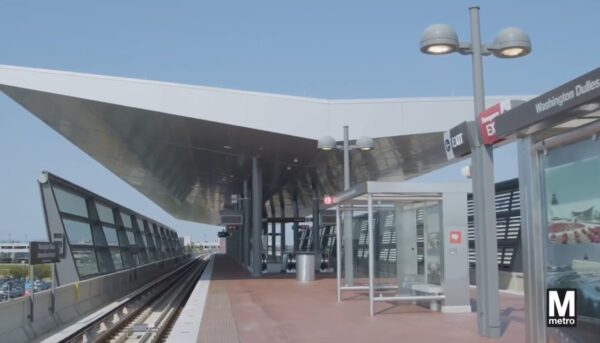
(Updated at 2 p.m.) It’s official: after years of rising costs and an ever-lengthening construction timeline, the second phase of Metro’s Silver Line has opened to the public.
A train pulled out of the new Dulles International Airport station for the first time shortly after noon following a celebration this morning, where local, state and regional leaders gathered to mark the opening of the 11.4-mile extension of the rail line into Loudoun County.
If everything went according to schedule, an express Silver Line train departed from the Wiehle-Reston East Metro station at 1:15 p.m., carrying winning “Silver Ticket” holders straight to Ashburn. The first passenger train from Ashburn to Downtown Largo will leave a little before 2 p.m., making all stops along the way.
First Silver Line train carrying local leaders, officials leaves the Dulles Airport Station #wmata @nbcwashington pic.twitter.com/S4fhh8fMSg
— Adam Tuss (@AdamTuss) November 15, 2022
At this morning’s ribbon-cutting ceremony, which started at 10:30 p.m. at the Dulles station, Rep. Don Beyer said the extension would usher a “once in a generation community infrastructure paradigm shift.”
Metro Board of Directors Chair Paul Smedberg lauded regional and local leaders for coming together to make what was a decades-log planning dream a reality.
“Today represents the best of what transit can do it,” Smedberg said.
Sen. Mark Warner said that the opening is the culmination of years of bi-partisan planning for decades.
“Every one of these speakers are going to come with partially silver hair at this point,” Warner said.
Others characterized the opening as an opening of new opportunities and possibilities.
Rep. Gerry Connolly (D-11) said that the project will produce an “incalculable return on investment” despite cost overruns and delays.
D.C. Mayor Muriel Bowser, who noted that today also marks the 60th anniversary of the airport, said she was confident that the Silver Line will offer a “comeback from Covid.”
Fairfax County Board of Supervisors Board Chairman Jeff McKay said the extension provides a much-needed investment for the local economy, noting that the county is a significant economic engine for the commonwealth overall.
The long-anticipated project, which cost upwards of $3 billion, brings six new Metro stations to Virginia and activates the Dulles International Airport and Loudoun County with Metrorail service.
“This is the result of what many people before us have done,” said U.S. Transportation Secretary Pete Buttigieg.
U.S. Department of Transportation @SecretaryPete sharing…
“What we see here with the ⚪️ Silver Line is democracy at work. Democracy 🇺🇸 in action can be a lot to bear. In the end, people have come together to make this work.” #SilverLineExtension #ridesilver #yourmetro #wmata pic.twitter.com/omKQPNp4Uz— Metro (@wmata) November 15, 2022

After years of anticipation and upwards of $3.1 billion in investments, phase two of the Silver Line will officially open to customers tomorrow.
Here’s a breakdown of everything you need to know about the 11.4-mile extension, which brings six new stations into Loudoun County. Notably, the extension provides a direct connection to Dulles International Airport, with its terminus in Ashburn.
The project also includes the largest rail yard in the Metro system — the Dulles Rail Yard — which is located on 90 acres of the Dulles Airport property.
Grand opening ceremonies
The first train will take off at 1:54 p.m. on the Ashburn Metro station, traveling the full 11.2-mile extension to Downtown Largo in Maryland. The deadline to snag one of 100 “Wonka-style ‘Silver Tickets'” for a preview ride at 1:15 p.m. ended last week via a social media contest.
A slew of grand opening ceremonies and celebratory events are planned throughout the day.
Dulles Airport gets its own big, invite-only ribbon-cutting. Then, at 2 p.m., the Fairfax County Department of Transportation will hold its own ceremony at the Innovation Center station.
Meanwhile, county officials will gather at the office building at 1950 Opportunity Way in Reston at 3:30 p.m. for another celebration. Attendees will get a chance to ride the new Reston Town Center shuttle and the new Fairfax Connector routes that start the next day, though service will officially launch Wednesday (Nov. 16).
Town of Herndon officials will also gather at 8 a.m. at the entrance of the Herndon Metro Station on the first full day of service — Wednesday — to celebrate the station’s opening. Newly re-elected Mayor Sheila Olem, State Senator Jennifer Boysko, and Dranesville District Supervisor John Foust are all scheduled to speak.
FCDOT is also planning a family day at the Innovation Center station from 10 a.m. to 2 p.m. on Saturday, Nov. 19.
How the extension works
Trains will run up to every 10 minutes during rush hour, every 12 minutes during midday, evening and weekends, and every 15 minutes during late-night hours.
Riding from the airport to the Metro Center station in D.C. takes around 52 minutes, while riding from the farthest station in Ashburn to Union Station takes 74 minutes.
Fares are based on distance travelled and the time of day, with costs ranging between $2 to $6. One-way trips after 9:30 p.m. are just $2. Metro offers a cost estimator to plan trips online.
Payment is made via Metro’s SmarTrip card, which can also be loaded to your mobile device. A plastic SmarTrip card can be purchased at all Metrorail stations, retail locations and online.
Getting to Metro
Each Silver Line station has a kiss-and-ride drop-off location — except the airport stop. Fairfax Connector buses are also available for all the stations. Detailed routes that service each station are available online.
Local jurisdictions own all the parking facilities near the Metro Stations. Parking fees can be paid by the SmarTrip card. Commuter parking is available for all but the airport and Reston Station stops.
Stations in Reston and Herndon
The Reston Town Center Metro Station (12023-A Sunset Hills Road Reston) is the first of the six new stations and includes two entrances on both sides of the Dulles Toll Road. While there’s no hourly parking in the kiss-and-ride lot, drop-offs are available on both sides. The facility also has 40 bike racks and 22 bike lockers. Future Capital Bikeshare stations are planned. But don’t bring your car and expect to leave it there — there’s no commuter parking.
The Herndon Metro Station (585-A Herndon Parkway) is near a planned transit-oriented development that hasn’t quite kicked off yet. While that project is still in the planning phases, the stop includes parking for roughly 3,500 cars in two garages, along with an exit to the Dulles Toll Road. The facility also has 162 bike racks and 18 bike racks. Two repairs stations and a bottle-filling station are also included.
The Innovation Center Metro Station (13747-A Sunrise Valley Drive) has a parking garage on the south side of the station for 2,000 cars, but parking is reserved and multi-day parking is not allowed. The facility has 177 bike racks and 10 bike lockers. Future electric vehicle charging stations are planned.
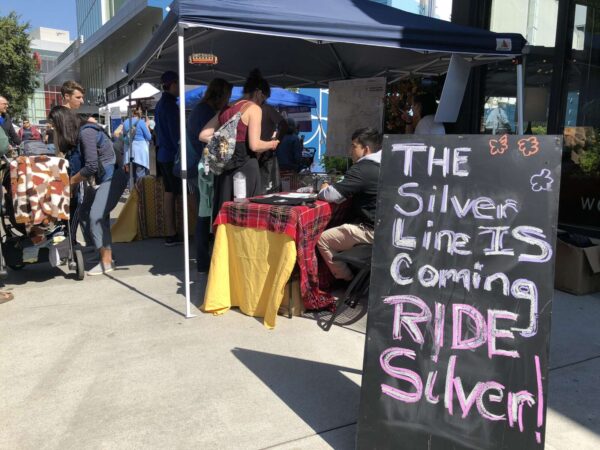
(Updated at 9:40 a.m. on 9/30/2022) Metro’s extension of the Silver Line through Herndon into Loudoun County is finally starting to look like a reality, instead of a hypothetical, albeit expensive, project.
The Washington Metropolitan Area Transit Authority unveiled new maps for its rail system last Friday (Sept. 23) that featured the six new stations, among other changes. A day earlier, its general manager got the go-ahead to set an opening date, though one has yet to be announced.
Coming six years after its initial projected opening of 2016, Silver Line Phase 2 will bring the D.C. region’s subway system into Loudoun for the first time, with stops at Dulles International Airport and Ashburn. Along the way, trains will pass through Reston Town Center, Herndon, and Innovation Center in the Dulles area.
Despite frustrations with the project’s many delays, Fairfax County officials remain hopeful that the rail line’s arrival will be a boon for residents and businesses in Reston and Herndon, fueling growth akin to what Tysons has seen since the Silver Line’s first phase opened there in 2014.
Are you excited to enter the shiny new Silver Line stations, potentially as soon as next month? Or have Metro’s ongoing safety and reliability issues turned you off of the transit system for now?
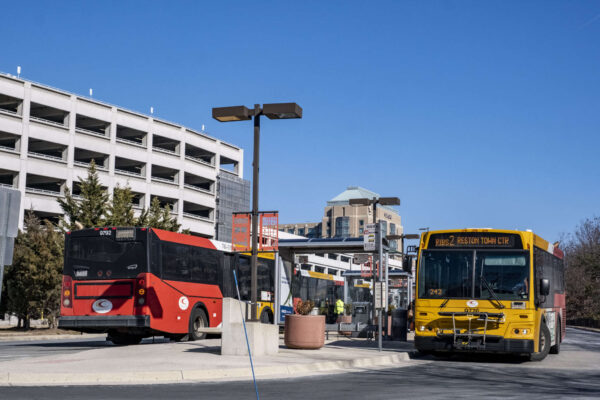
The Fairfax Connector is getting a few changes (page 228) starting early next year, including a new route along I-66’s express lanes with more Vienna connections on the horizon.
At a meeting on Sept. 13, the Board of Supervisors unanimously approved several changes that could expand the reach and efficiency of transit around the Tysons area.
“Staff proposes service changes for implementation on January 14, 2023, to improve the customer experience and increase ridership through improved connectivity, on-time performance, service reliability, and effectiveness,” staff said in a report.
There are four changes planned for January. The big one for Tysonians is a new route that would use the I-66 express lanes for a better Tysons-Centreville route.
“County staff worked with the Department of Rail and Public Transportation (DRPT) to develop Route 660 that will operate along I-66 using the new express lanes,” the report said. “The route will improve connectivity between Centreville and Tysons, which is a major employment center, and will provide additional connections for passengers at the Government Center and Vienna Metrorail Station.”
According to the report:
- Route 660 will provide weekday commuter service with 10-minute frequency during peak periods.
- Reduces travel time from Centreville to Tysons by approximately 30 percent.
- The estimated total annual revenue hours are 17,300.
- The estimated total annual operating cost is $2.3 million, which will be funded through a DRPT grant using I-66 Outside the Beltway (OTB) toll revenue.
- The vehicles needed to operate this route have already been purchased by the County using funds from DRPT
One of the other changes is the elimination of Route 644 to avoid duplication with the new Route 660.
“The connection from the Stone Road Park-and-Ride Lot to the Vienna Metrorail Station will be served by Route 660 with improved frequency,” the report said. “The entire service that Route 644 currently provides will be covered by Route 660.”
Other planned changes include shifting Route 937 (serving Innovation Center and Herndon Metro) and Route 951 (serving Innovation Center, Herndon, Reston Town Center) slightly south.
In a separate action item, the Board of Supervisors also approved funding from the I-66 Outside the Beltway tolls into two additional bus routes:
- Route 670 – Chantilly to Franconia-Springfield Metrorail Station with connections at the Monument Drive multimodal facility and Vienna Metrorail Station
- Route 698 – Stringfellow Park-and-Ride Lot to the Vienna Metrorail Station with through connections to the Pentagon during peak periods
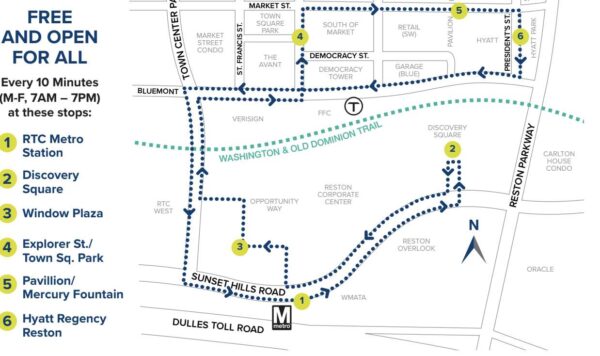
A new free shuttle service is coming soon to Reston Town Center to connect the RTC Metro Station to Reston’s urban core.
LinkRTC, the new, privately-funded shuttle service managed by the Reston Town Center Association, is expected to begin operation on weekdays when the station opens in the fall. Six stops are planned for the internal shuttle, which will provide free service from 7 a.m. to 7 p.m. on weekdays.
RTCA Executive Director Robert Goudie said the shuttle is intended to connect the area’s residents, workforce and visitors to a network of restaurant, retail, workplaces and programming.
“The town center continues to grow as a dynamic, regional destination,” Goudie wrote in a statement. “We see linkRTC as an important community amenity that will link the downtown with Metro.
Reston Limousine and Travel Service, a local transportation company, will operate two 14-passenger vans that will run with 10-minute intervals between service at each stop. The company has more than 250 vehicles.
The vans are ADA-compliant and include two wheelchair-accessible seating places. Properties within RTCA that opt in will pay for the service under a cost-sharing agreement.
“As we explored this with our major property holders, it became clear that a sensible first phase would be rolling this out within the extended urban core,” Goudie told FFXnow. “Once we launch, other properties that might wish to have a stop and be a part of the funding solution can contact us about the possibility of opting in. It may be a service we can voluntarily grow over time.”
Goudie anticipates expanding the program throughout the town center in the years ahead.
Hunter Mill District Supervisor Walter Alcorn says the shuttle will help bolster Fairfax County’s vision of ensuring that development allows people to get to transit easy.
“This supports Fairfax County’s investment in Metrorail, provides another multi-modal option to the growing Reston Town Center, and creates another alternative to single occupancy private vehicles in the heart of Reston. These are things that everyone in our community should support,” Alcorn wrote in a statement.
RTCA is the governing association for RTC.
Signs will be posted at each stop. An app will also be available for riders.
The shuttle has been in the works for years. The county’s latest comprehensive plan for Reston contemplates the inclusion of a shuttle or circulator service to knit the town center with Metro.
RTCA will launch the service once trains begin running at the station, possibly in October of this year, after years of delays.
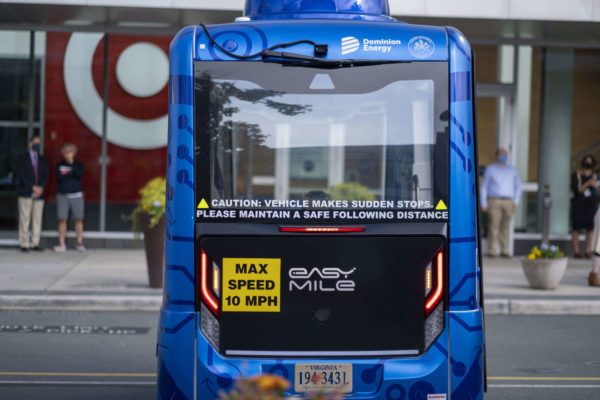
The autonomous Relay shuttle that has been puttering around Merrifield will stay in operation at least through the end of this year.
Fairfax County accepted additional funding from the Virginia Department of Rail and Public Transportation last week to extend its pilot project through December 2022, as it hopes the recent decline in COVID-19 cases will boost the shuttle’s ridership.
The $208,000 state grant is supplemented by a required local match of 20%, or $52,000, bringing the total amount to $260,000, according to county documents.
“Ridership levels have still been relatively low due to omicron and winter weather, but we are expecting an increase during the summer,” Robin Geiger, head of communications for the Fairfax County Department of Transportation, told FFXnow.
The Relay shuttle opened to passengers on Oct. 22, 2020, in the Mosaic District. It is free to ride and travels between Barnes & Noble and the nearby Dunn Loring-Merrifield Metro station between 10 a.m. and 2 p.m. on Mondays through Thursdays.
A partnership between the county and Dominion Energy, which provided the shuttle, the demonstration project is Virginia’s first state-funded use of a self-driving, electric vehicle in public transportation.
The county enlisted the Virginia Transportation Research Council and Virginia Tech to conduct an independent study of the technology and the service’s effectiveness as a transportation option, but that effort has been unavoidably shaped by the pandemic.
Though the shuttle can accommodate up to 12 passengers, capacity has been limited to three people, including a safety attendant, throughout the pilot to encourage social distancing.
Geiger notes that face masks are also required on the shuttle as long as the federal mask mandate for public transportation remains in effect, which is currently through April 18. Governors from 21 states, including Virginia Gov. Glenn Youngkin, filed a lawsuit against President Joe Biden’s administration yesterday (Tuesday), calling the mandate an example of federal overreach.
Despite the challenges presented by COVID-19 and some more mundane logistical issues, such as drivers illegally passing the 10 mile-per-hour vehicle, the Relay pilot “has been going well” overall, Geiger says, adding that the county has been learning throughout the experiment.
The shuttle will be on display this weekend (April 2-3) at the Mosaic District’s “Art Blooms” festival, a celebration of spring in partnership with the National Cherry Blossom Festival in D.C.
Art Blooms at Mosaic will also feature crafts and farmers markets, a beer garden from Caboose Brewing Company, a wine garden, live musical performances, and various family-friendly activities, such as face-painting and cooking demonstrations.
“[Relay] will not be operating during the festival, but we will be promoting the days and hours of service,” Geiger said.
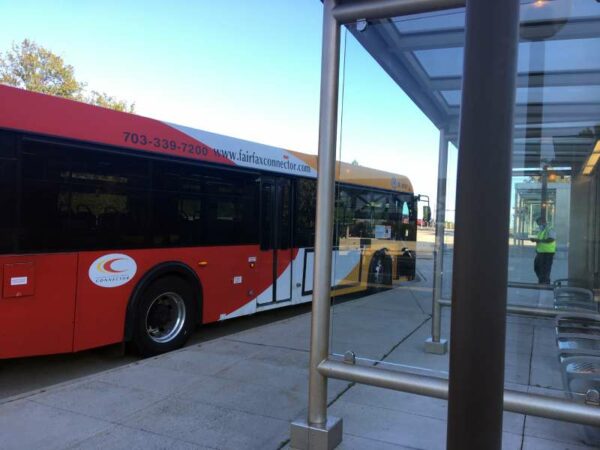
Fairfax County is seeking community input to guide the future of its Fairfax Connector bus system.
The Transit Strategic Plan review will examine how service could be adapted to address community needs over the next 10 years.
A survey open to everyone, regardless of their current Fairfax Connector usage, launched on Tuesday (March 22). Responses will be accepted through April 16.
The Fairfax County Department of Transportation will also hold online meetings on March 28 and 31.
Available in 10 different languages, the survey addresses existing routes — which could be tweaked with more frequent buses, for example — as well as potential new routes. The plan will also look at whether more bus stops are needed, why routes might be underperforming, and other considerations.
“Your input is crucial,” Michael Felschow, the county’s transit planning section chief, said during a public meeting on the plan in January 2021.
The final result will be a priority list of services and investments in capital and infrastructure projects that Fairfax County can try to implement over the next decade, he noted.
This is the second round of community engagement for the Transit Strategic Plan, which is required by state law for large public transportation agencies. FCDOT previously held public meetings and shared a survey during January and February 2021.
The plan will incorporate findings from more short-term studies that the county has been conducting over the past few years for specific parts of the bus system, including Herndon and Reston, Franconia and Springfield, and the Tysons and Chantilly areas.
Bus service in Huntington is being evaluated as part of the Richmond Highway bus rapid transit project, according to the news release.
Staff will eventually submit a plan to the Fairfax County Board of Supervisors for approval, possibly by the end of the year.
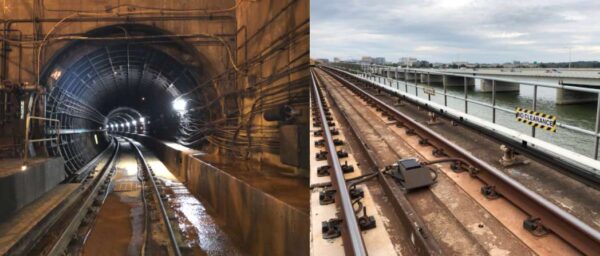
The Fairfax County Board of Supervisors and other Northern Virginia officials are looking for ways to help commuters during a lengthy planned shutdown of Metro’s Yellow Line for rehabilitation work.
The Washington Metropolitan Area Transit Authority will stop service on a key section of the line for seven to eight months to repair a Yellow Line bridge over the Potomac River and tunnels that are over 40 years old.
The project is scheduled to start in September and finish in the spring. The shutdown will be between the Pentagon and L’Enfant Plaza stations.
“The seemingly endless stream of shutdowns, delays, and missed completion dates is making Fairfax County commuters increasingly frustrated and hampering Metro’s ability to rebound from pandemic ridership numbers,” Chairman Jeff McKay said during the board’s meeting yesterday (Tuesday).
The board agreed to write a letter urging WMATA to accelerate the project timeline and provide more alternatives for commuters, such as improved bus service and parking fare reductions at Yellow Line stations during construction.
McKay also encouraged Virginia Railway Express to play a “lead role in possibly providing relief in ways like fare incentives for Yellow Line riders.”
The work is occuring at the same time the new Potomac Yard Metro station is being connected to rail lines as part of a six-week project. The station is slated to open this fall, following delays.
McKay said that while safety must be the highest priority, he’s concerned about the effects of the shutdown, especially as people return to the workplace. Metro service has already been significantly reduced systemwide for months since a train derailed in Arlington County in October.
“WMATA needs to find a way to shorten that timeframe and do a better job of at least getting our commuters through that bottleneck, which is frankly, for us, Alexandria,” Mount Vernon District Supervisor Dan Storck said.
The Mount Vernon District borders the City of Alexandria and includes the Huntington Metro station at the end of the Yellow Line.
“That’s not a criticism of Alexandria,” Storck added. “It’s just the amount of people that’s going to go through it is even more than in the past.”
WMATA spokesperson Sherri Ly said the authority is working with its regional partners, businesses and the community to create a mitigation plan, including bus service enhancements and changes to parking policy for the project’s duration.
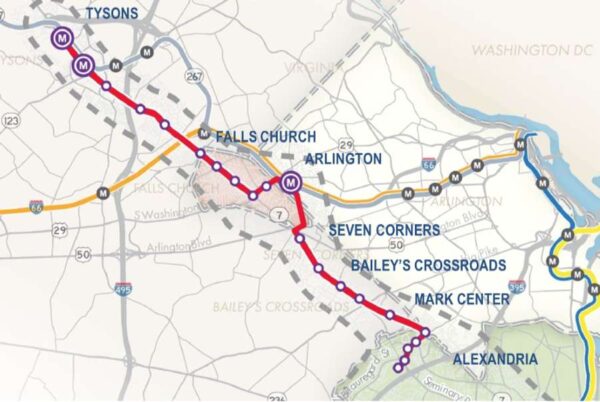
Fairfax County officials have not ruled out the possibility of incorporating pull-off areas on Route 7 for the bus rapid transit (BRT) system planned along the corridor from Tysons to Alexandria.
Areas for buses to pull off or pass each other would let the road accommodate an express service for riders who want to get from one end of the route to the other without having to make every stop in between, Springfield District Supervisor Pat Herrity proposed at the county Board of Supervisors’ meeting yesterday (Tuesday).
“I’m hoping that as we move this project forward — if we move this project forward — we take into account the ability to get people there more quickly and have the option to do express routes, so that we can actually get people on these buses and using them,” Herrity said.
As evidence that transit’s success depends on providing shorter trip times than driving, he cited the collapse of Fairfax and Arlington counties’ plans for a streetcar on Columbia Pike a decade ago. A suggested bus rapid transit alternative never materialized either.
County and regional transportation staff can look at including pull-off areas once they start designing the bus service, Fairfax County Department of Transportation Director Tom Biesiadny told the board, but that phase of the project is still months away.
The Fairfax County Board of Supervisors voted yesterday to authorize an agreement with the Northern Virginia Transportation Commission that commits the county to providing $25,000 for a “project roadmap,” which will guide the BRT’s implementation, including a timeline and possible funding sources.
Under the agreement, NVTC will contribute $50,000 and hire a contractor to develop the roadmap. The regional organization is leading the Envision Route 7 BRT project, since it involves the cities of Falls Church and Alexandria as well as Fairfax County.
NVTC is currently working on the fourth phase of a mobility study evaluating the benefits and impacts of the proposed service. Initiated in October, this phase focuses on the route from Tysons to Seven Corners and could take 12 to 18 months, the project page says.
A follow-up study will look at the rest of the route from Seven Corners to Mark Center in Alexandria.
Fairfax County’s board approved the Tysons portion of the route in July. FCDOT is now working on an amendment to add BRT to the county’s comprehensive plan, which is expected to come before the board this spring, and preparing preliminary conceptual engineering designs, according to county staff.
While having express service as part of a “rapid” bus system seems like a “no-brainer,” in Dranesville District Supervisor John Foust’s words, Biesiadny said pull-off or passing areas would require more land and right-of-way for the project.
The cost, environmental impact, and potential displacement of residents and businesses along Richmond Highway led the county to eschew an express service for its upcoming Route 1 BRT, according to Board of Supervisors Chairman Jeff McKay, who disputed Herrity’s characterization of the decision as a missed opportunity.
The Richmond Highway BRT, which has been branded The One, will have a total of nine stops, still providing a shorter ride than the existing Fairfax Connector and Metrobus service in the corridor, Biesiadny noted.
“We didn’t expect that there would be a significant amount of congestion in the bus lanes, nor significant delay for those buses as they travel from Fort Belvoir up to the Huntington station,” he said. “But we will look at that again as part of the Route 7 project, and we’ll be able to have a discussion with the board in terms of the pros and cons of doing something different in the Route 7 corridor.”
He confirmed that FCDOT is looking at providing transit-exclusive lanes for the county’s Route 7 BRT segments, as proposed by an NVTC conceptual engineering study.

